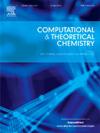Accelerating design of phthalocyanine-based catalysts for electrocatalytic reduction of nitric oxide: A DFT and machine learning study
IF 3
3区 化学
Q3 CHEMISTRY, PHYSICAL
引用次数: 0
Abstract
Nitrogen oxide reduction reaction (NORR) is a highly efficient method for reducing NO to synthesize ammonia. Herein, we designed 18 transition-metal (TM)-doped phthalocyanine materials and combined density functional theory (DFT) with machine learning (ML) to systematically study their catalytic performance for NORR through comprehensive evaluations of their NO adsorption energy, electronic structure, and Gibbs free energy. Our results indicate that NO can adsorb on V1@Pc with a moderate adsorption energy (−2.29 eV) and the lowest limiting potential (0.38 V) among the 18 TM1@Pc materials. Additionally, V1@Pc can effectively mitigate the competitive hydrogen evolution reaction (HER), showing that it has a remarkable performance of efficiency and selectivity for NORR. Finally, machine learning techniques were employed to construct predictive models by utilizing key feature descriptors derived from DFT calculations and intrinsic atomic properties. Among the five regression models, the Random Forest Regression (RFR) exhibits the highest accuracy (R2 = 0.99) and the lowest RMSE (0.15 eV) in predicting Gibbs free energy. Our study may provide valuable theoretical insights for the rational design of high-performance electrocatalysts for NORR.

氧化氮还原反应(NORR)是还原 NO 合成氨的一种高效方法。在此,我们设计了 18 种过渡金属(TM)掺杂的酞菁材料,并将密度泛函理论(DFT)与机器学习(ML)相结合,通过对其 NO 吸附能、电子结构和吉布斯自由能的综合评估,系统地研究了它们在 NORR 中的催化性能。我们的研究结果表明,在 18 种 TM1@Pc 材料中,NO 能以中等吸附能(-2.29 eV)和最低极限电位(0.38 V)吸附在 V1@Pc 上。此外,V1@Pc 还能有效缓解竞争性氢进化反应(HER),表明其在 NORR 的效率和选择性方面具有显著的性能。最后,研究人员采用机器学习技术,利用从 DFT 计算和内在原子特性中得出的关键特征描述符构建了预测模型。在五个回归模型中,随机森林回归(RFR)预测吉布斯自由能的准确度最高(R2 = 0.99),RMSE 最低(0.15 eV)。我们的研究可为合理设计用于 NORR 的高性能电催化剂提供有价值的理论启示。
本文章由计算机程序翻译,如有差异,请以英文原文为准。
求助全文
约1分钟内获得全文
求助全文
来源期刊

Computational and Theoretical Chemistry
CHEMISTRY, PHYSICAL-
CiteScore
4.20
自引率
10.70%
发文量
331
审稿时长
31 days
期刊介绍:
Computational and Theoretical Chemistry publishes high quality, original reports of significance in computational and theoretical chemistry including those that deal with problems of structure, properties, energetics, weak interactions, reaction mechanisms, catalysis, and reaction rates involving atoms, molecules, clusters, surfaces, and bulk matter.
 求助内容:
求助内容: 应助结果提醒方式:
应助结果提醒方式:


